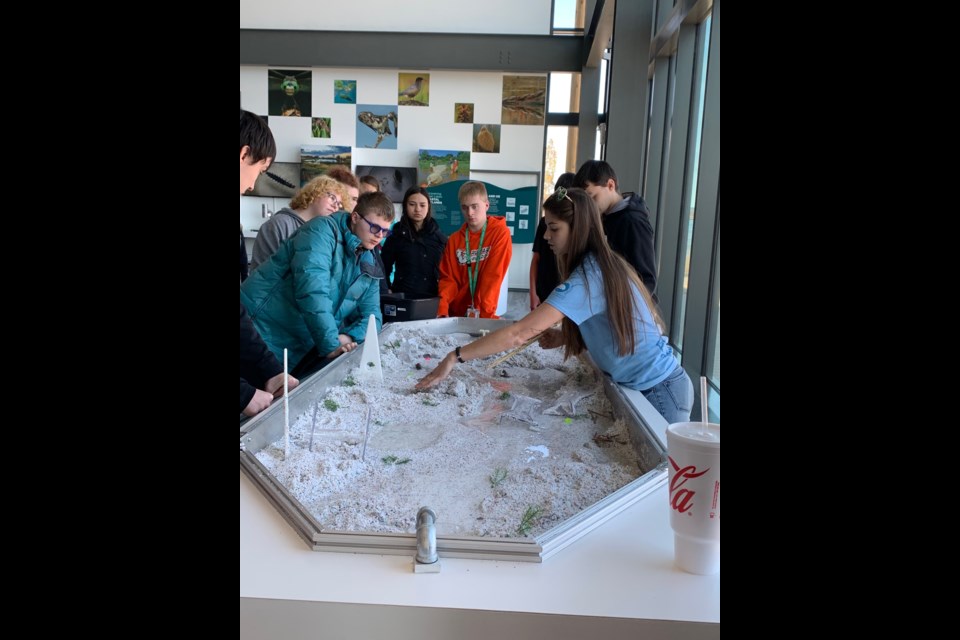Eastern Upper Peninsula Intermediate School District (EUPISD) Learning Center students were hooked by their field trip to the Center for Freshwater Research and Education (CFRE) last Wednesday.
“We learned about life cycles of fish and the force of water, since we just completed a unit on forces in nature,” said ISD Special Education Teacher Gwen Malaska.
CFRE Great Lakes Education and Outreach Specialist Beth Christiansen partnered with Lake Superior State University (LSSU) graduate Aspen Schupbach to create visual and kinesthetic educational activities involving the Cloverland Electric Cooperative hydroelectric plant, ecosystems and invasive species.
Water flowing down a power canal and into its gates to spin turbines that rotate a generator may not read and/or sound interesting to all learners. That's also true with lifeforms living in disrupted ecosystems. But the trip managed to make it a fun experience.
An interactive board allowed the students to turn a small turbine to replicate hydroelectric generation.
“Aspen ran an activity where the students built the food chain, so they started with the tiny little algae,” said Christiansen. “The little plankton eat the algae. The students got to build on that. I had a bunch of bugs and insects that we looked at. We have insect communities."
Students identified insects with magnifying glasses and water samples from the St. Marys River under lenses.
“How many sensitive insects you have in here will tell you about the water quality,” said Christiansen, showing glassed water bugs specimens. “If you have a lot of insects that are sensitive to pollution, there's a chance the water quality isn't good.”
Printed scavenger hunts gave students the chance to explore pollution and its impacts. When finished, they went downstairs to pet the male and female sturgeons. They talked all about fish.
“We were learning about fish in the Great Lakes,” said ISD student Gavin Michael Clark, who was excited to pet and learn about the facility’s sturgeons. “Fish are part of the food chain. They are good swimmers. Lake sturgeons are the oldest fish in the Great Lakes. We learned how big they get. They live up to 84-years-old. Females live to be about 100 to 120-years-old. They can live in cold water. They can live in deep water with no sunlight.”
All fish need water and the oxygen in it to survive.
This particular bottom-feeder also eats shellfish and gastropods to survive. As part of the food chain, many people and animals consume sturgeons. But people threaten the species when heavily fishing and/or harvesting for caviar. Further, all water life is threatened by human pollution.
“They discussed a food web program where the focus is interactions within the ecosystem,” said Christiansen. “It’s about how plants, animals, water, air and all that interact.”
A hands-on watershed table filled with sand demonstrated how water runoff and pollutants enter ponds, lakes, bays, rivers, and oceans.
Christiansen believes in teaching future generations how to protect our waters and the life living within them. Students and families are invited into the CFRE to learn about all things freshwater.
“Through the Michigan Invasive Species Grant program, I have nine teachers from six different schools in northern Michigan,” said Christiansen with a smile. “I think we have 190 students developing community action projects within their communities to inform, educate and take action against invasive species.”
Back at the ISD, this particular transition class has helped to plant and nourish the growth of 750 plants. They sell the plants to the public for $1 each.
"These kids also make crafts, candles, grow pepper and tomato plants,” said Malaska.
The entire community gets involved in purchasing and donating, enabling the students to earn money for field trips geared toward their transitions into the "real world."
“The money goes to transition skills, helping them transition into adult life,” said Malaska. “My class is a transition class, where we prepare students for life. Part of that is being able to get around the community and learning to use EUPTA.”
Each student came with $12 to learn how to spend. Lunch for the group was at Jose's Restaurant.
“I ordered two tacos for $5.25, and have enough for a tip,” said ISD student Dominic Ryon, who enjoyed the educational field trip to CFRE.
But that is not all these hearts of gold have spent their hard earned money on.
“They voted to give money to a high school student who needed a new outfit to go on an art trip,” said Malaska. “They have given money to people in the community who have lost jobs due to sickness. They were able to donate to the hospice center.”
The ISD Learning Center class will be selling a variety of pepper and tomato plants later this month for a special trip just for them.
“We are going to Mackinac Island in June,” said Malaska.
The students are having a plant sale May 23 through 27 from 9 a.m. to 2 p.m. out of the brown building near the bus garage at the Eastern Upper Peninsula Intermediate School District Learning Center on 11185 W. 2nd Street, Rudyard, MI.
The Center for Freshwater Research and Education is open to the public every Friday from 2 p.m. to 6 p.m. and Saturday from 10 a.m. to 2 p.m.



